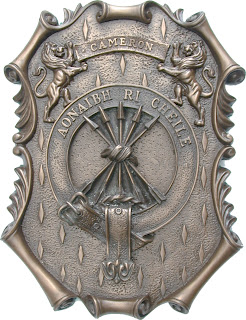Origin of Name: Henry's son
Gaelic Name:
MacEnnuig
Clan Crest: A hand holding an estoile
or a six-pointed star
surmounted by a
crescent.
Clan Motto:
Sola virtus nobilitat (Virtue alone
ennobles)
Lands:
Caithness and Glencoe
The Hendersons are an ancient Clan,
tracing their ancestery back to the Picts, Scotland’s earliest people. Clan
Henderson descend from the Pictish prince Eanruig Mor, meaning "Big
Henry", whose family became known in the Gaelic tongue as Maceanruig, or
"son of Henry". Through the course of time the name became anglified
to the current form of Henderson, although Gaelic forms of the name exist.
Eanruig Mor was the son of King Neachtain, who ruled the Pictish kingdom from
700 to 724, & is reputed to have contructed the great Pictish fortress of
Abernethy. Clan Henderson lived amid the rugged splendour of Glencoe in the
northern Highlands, while other branches of the Clan settled in the Scottish
border territory & in the far north district of Caithness.
The border Hendersons soon rose to
prominence, holding powerful positions in the mighty strongholds which were
such an integral part to the defence of Scotland. One of these great men,
William Henderson, was the chamberlain of Lochmaben Castle during the 14th
Century. Another, James Henderson, became Lord Advocate in 1494, was appointed
to the bench, and acquired the lands of Fordell in Fife for the Clan. Here he
built the magnificent fortified mansion of Fordell Castle. The Hendersons were
classed as a riding clan, but were sufficiently loyal to evade the Scottish
Parliament’s 1594 list of turbulent border clans that were to be suppressed.
The success of the Clan Henderson continued to escalate, and by the 17th
Century the Clan boasted one of the most notable figures in Scottish politics
and church affairs. Alexander Henderson draughted the National Covenant in
1638, in defence of the Scottish Church and denouncing the changes that Charles
I intended to introduce. Alexander was elected moderator of the General
Assembly, and was responsible for meeting and negotiating with the King after
he surrendered to the protection of the Scottish army in 1646, during the Civil
War. Another great Henderson, Thomas Henderson, was a 19th Century astronomer
of the highest status, and was appointed as the first Astronomer Royal for
Scotland.
The
Hendersons of Glencoe were closely aligned to the great Clan Macdonald, for
whom they acted as heriditary pipers. The Hendersons were renowned for their
fighting ability, and they traditionally formed the bodyguard of the Macdonald
chief. This duty they performed with verve, and many Hendersons were killed
during the infamous Glencoe massacre. On this dark day, the Campbells
villanously broke all the rules of Highland hospitality and murdered their
hosts, the Macdonalds of Glencoe. The chief’s piper and right hand man, Big Henderson
of the Chanters, a strongman over six and a half feet tall, was among those who
laid down their lives to defend their friends and allies in the Clan Macdonald.
The
chief of the Clan Henderson is Alistair
Henderson of Fordell who resides in
Queensland, Australia. He is
recognized by Lord Lyon, King of Arms, and is a member of the Standing Council
of Scottish Chiefs.
The
Clan Henderson crest is surmounted by a
hand holding an estoile or star surmounted by a crescent. The proud
Hendersons clan motto reads "Sola virtus nobilitat" which means in
Latin "Virtue alone ennobles".
scottishclancrests.co.nz








